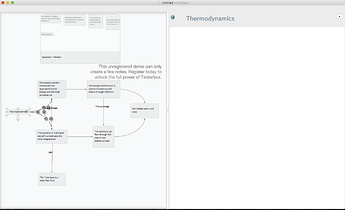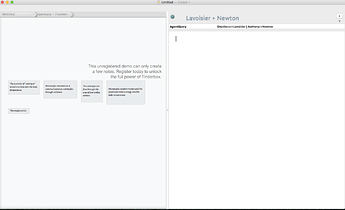I do not worry about performances. All notes I have are very un-styled notes (I should say “thoughts”) with a few words. Most of them are in fact just references: book name, relevant page (where I can find highlighted lines in my IRL books).
My concern is about links. I need a tool that enable visual exploration of notes to find new relations. I’m particularly interested in Tinderbox precisely because:
I’m ready to learn a bit of code synthax if this can open the way I look at my notes.
So… I manage to have the VM working, I intalled the Tinderbox trial and tried to design my example:
- I have the notes about Lavoisier thermodynamics that have “Author2=Lavoisier” attribute
- I have the notes about Newton thermodynamics that have “Author3=Newton” attribute.
- Some notes have no attributes.
- I created an agent called “Lavoisier+Newton” that query “$Author2==Lavoisier | Author3==Newton” and collect the notes I want to see. I use the Agent as a note filter.
I realized that this method do not diplay the links in the Agent (see image below). I also see that linking two notes in the agent (Aliases) do not impact the originals. That’s the two things I’d like to be able to do.
Is there something I did wrong? Or do I simply not use the right global approach of the problem? I think I understood aliases as “replicants” but they are not. I’ve found some threads about replicants in Tinderbox and it feels like a touchy question…
I’ve looked over the references given above by many of you but I have to confess that there is a lot to read and learn, too much for a first try (for me at least).
May I ask you some help to buid this simple case?

